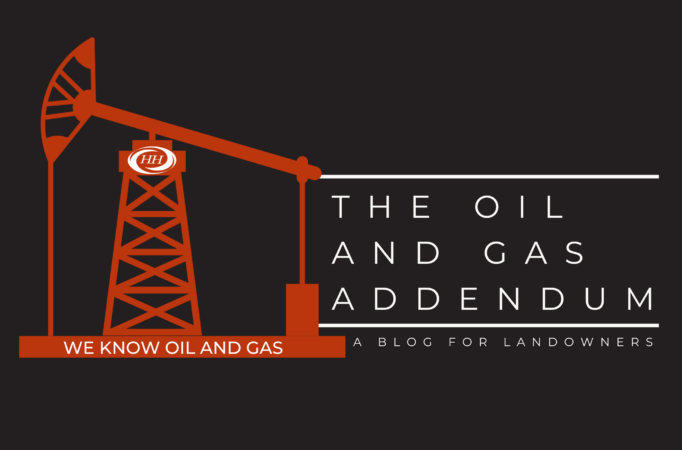The Oil and Gas Addendum
The Strip and Gore Doctrine - Who Really Owns The Oil and Gas Under Roads and Highways?
Let’s assume your grandfather owned 99 acres in Washington County. In 1955, he sells a small portion of the farm to the Commonwealth of Pennsylvania in order to facilitate the construction of new State Route 39. This acreage consists of a narrow strip of land 500 feet wide running in a north – south direction (the “Roadway Tract”) through the farm. The 1955 Deed reserves the oil and gas underlying the twenty (20) acre Roadway Tract. Thereafter, State Route 39 is constructed and runs in a north -south direction through the farm, with the farm now on both sides of the road. Several years later in 1964, your grandfather sells the remaining farm acreage (i.e., 79 acres) to Farmer Jones. The 1964 Deed does not reserve the oil and gas. In 2018, you are approached by a landman for Big Oil, Inc. to lease the Marcellas Shale formation under the Roadway Tract. You happily sign the lease and begin to receive production royalties two years later. Then, the royalties suddenly cease. Big Oil, Inc. contacts you and says there was a mistake: you do not own the oil and gas under the Roadway Tract. Although the 1955 Deed attempted to reserve the oil and gas, these rights were subsequently conveyed to Farmer Jones by virtue of the 1964 Deed. The representative from Big Oil, Inc. refers to something known as the “strip and gore” doctrine. You are angry, frustrated and confused – how did the 1964 Deed operate to convey the oil and gas under the Roadway Tract? As we have written before, confirming the ownership of oil and gas under streams and rivers can be complex and confusing. See, Pennsylvania Landowners May Not Own Oil and Gas Rights Under Rivers and Streams (April 2016). Questions regarding the ownership of the oil and gas under roads and streets can be equally challenging. And, peculiar rules, such as the “strip and gore” doctrine, can create additional frustration for landowners.
When tasked with interpreting a deed, the objective of the reviewing court is to ascertain the intent of the parties. One such method is the so-called “strip and gore” doctrine. The doctrine is often invoked to resolve questions as to the ownership of oil and gas underlying roads and highways. How does it work? It essentially creates a presumption against separate ownership of a narrow strip of land adjacent to a larger tract. The doctrine presumes that the grantor did not intend to retain title to the narrow strip of land (i.e., often a roadway) adjacent to the larger tract being conveyed to the grantee. In other words, if the subject property is bounded on the west by a roadway, and the deed specifically describes the western boundary of the subject property as being the road, a question arises as to whether the grantor intended to convey the oil and gas under the road along with the subject property or did he intend to retain the narrow strip underlying the road? If the doctrine is found to apply, title to both tracts ( i.e. the adjacent tract and the road tract ) are presumed to pass to the grantee. See, Crawford v. XTO Energy, No. 02-18-00217 (Tex App. – Fort Worth, 2019) (“[T]he strip and gore doctrine is used to aid in determining a grantor’s intent – not as to the land described in the deed itself but as the adjoining land not referenced in the deed”); See also, Escondido Services v. VKM Holdings LP, 321 S.W. 3d 102 (Tex. App.- Eastland 2010) (the doctrine applies when the strip “ceases to be of benefit or importance to the grantor of the larger tract by the time of its conveyance”); Strayhorn v. Jones, 300 S.W. 2d 623 (Tex. 1957) (noting the doctrine applies only if the narrow strip of land is not specifically referenced or mentioned in the disputed deed).
It is well-established that when the legal description in a deed references a road or highway, the owner of the adjacent tract typically “owns” the subsurface to the middle of that roadway. See, Rahn v. Hess, 378 Pa. 264 (Pa. 1954)( “….It is settled law in Pennsylvania that where the side of the street is called for as a boundary in a deed, the grantee takes title to the center of it…”). So, if a property is bounded on the west by a road, any conveyance of that property will typically include to the middle of the road. But what happens when the subject property to be conveyed is on both sides of the road? The centerline presumption set forth in Rahn does not apply because the road is not technically a boundary. And if the deed does not specifically reference the oil and gas underlying the road, a question arises as to whether those rights are being conveyed along with the larger adjacent tracts. Is that narrow strip ( i.e. the roadway ) being retained by the grantor? Enter the “strip and gore” doctrine.
As recently observed by the Texas Court of Appeals, the “strip and gore” doctrine is “highly policy driven” and its purpose is to discourage title disputes and litigation by “providing certainty in land titles”. It does so by creating a rebuttable presumption that the grantor did not intend to retain a narrow strip of land in between the larger adjacent tracts being sold to the grantee, especially when the narrow strip is of no practical value to the grantor. In order for the doctrine apply, however, the proponent must show that: i) the narrow strip is small in size and value in comparison to the conveyed tract and is “no longer of importance or value to the grantor”, ii) the narrow strip was not included in the actual property description set forth in the subject deed and iii) no other language in the subject deed indicates that the grantor intended to reserve an interest in the narrow strip of land. See, Green v. Chesapeake Exploration LLC, No.02-17-00405 ( Tex. App- Fort Worth 2018). The most challenging element is establishing whether the narrow strip is “no longer of importance or value to the grantor”.
Prior to the advent of horizontal drilling and hydraulic fracturing, the ability to access and extract hydrocarbons from small, narrow and isolated strips of land was limited. As such, application of the doctrine made sense. But, that dynamic has changed now that the horizontal drilling is common and widespread. Such strips do have value as surface access is of less importance today. Nonetheless, Texas courts continue to apply the doctrine by requiring that the strip “ceased to be of benefit or importance to the grantor……by the time of the conveyance.”. See, Escondido Services LLC v. VKM Holdings LP, 321 S.W. 3d 102 ( Tex App- Eastland 2010). So, the focus of the inquiry is whether the strip had value at the time of the alleged conveyance- if that deed pre-dates horizontal drilling a strong argument can be made that the strip had little or no value at that time because no well could access the hydrocarbons underlying the strip. See, Crawford v, XTO Energy ( applying the doctrine to a 1984 deed and observing that “[w]ithout the ability to access the Disputed Tract after conveying the adjoining lands, Ms. Crawford’s interest was of little to no practical value…..”); See also, Plainsman Trading Co. v. Crews, 2018 WL 6565790 ( Tex 1995)( “…..practically speaking, a mineral estate would be wholly worthless if the owner of the minerals could not enter upon the land in order to explore for and extract them”).
Returning to our example, an argument could be made that when your grandfather conveyed the remaining farm acreage to Farmer Jones in 1964, he no longer had the ability to access the hydrocarbons underlying the Roadway Tract. Horizontal drilling had not been perfected and he no longer could drill a well from adjacent tracts. As such, under the “strip and gore” doctrine, a presumption arises that your grandfather did not intend to retain the Roadway Tract when he executed the 1964 Deed.
Determining the ownership of oil and gas under roads and highways can be confusing and complex. If you have a road that runs through your property and have questions about the underlying oil and gas rights, please call Robert J. Burnett at 412-288-2221.
About Us
Oil and gas development can present unique and complex issues that can be intimidating and challenging. At Houston Harbaugh, P.C., our oil and gas practice is dedicated to protecting the interests of landowners and royalty owners. From new lease negotiations to title disputes to royalty litigation, we can help. Whether you have two acres in Washington County or 5,000 acres in Lycoming County, our dedication and commitment remains the same.
We Represent Landowners in All Aspects of Oil and Gas Law
The oil and gas attorneys at Houston Harbaugh have broad experience in a wide array of oil and gas matters, and they have made it their mission to protect and preserve the landowner’s interests in matters that include:
- New lease negotiations
- Pipeline right-of-way negotiations
- Surface access agreements
- Royalty audits
- Tax and estate planning
- Lease expiration claims
- Curative title litigation
- Water contamination claims

Robert Burnett - Practice Chair
Robert’s practice is exclusively devoted to the representation of landowners and royalty owners in oil and gas matters. Robert is the Chair of the Houston Harbaugh’s Oil & Gas Practice Group and represents landowners and royalty owners in a wide array of oil and gas matters throughout the Commonwealth of Pennsylvania. Robert assists landowners and royalty owners in the negotiation of new oil and gas leases as well as modifications to existing leases. Robert also negotiates surface use agreements and pipeline right-of-way agreements on behalf of landowners. Robert also advises and counsels clients on complex lease development and expiration issues, including the impact and effect of delay rental and shut-in clauses, as well as the implied covenants to develop and market oil and gas. Robert also represents landowners and royalty owners in disputes arising out of the calculation of production royalties and the deduction of post-production costs. Robert also assists landowners with oil and gas title issues and develops strategies to resolve and cure such title deficiencies. Robert also advises clients on the interplay between oil and gas leases and solar leases and assists clients throughout Pennsylvania in negotiating solar leases.

Brendan A. O'Donnell
Brendan O’Donnell is a highly qualified and experienced attorney in the Oil and Gas Law practice. He also practices in our Environmental and Energy Practice. Brendan represents landowners and royalty owners in a wide variety of matters, including litigation and trial work, and in the preparation and negotiation of:
- Leases
- Pipeline right of way agreements
- Surface use agreements
- Oil, gas and mineral conveyances

